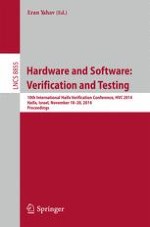2014 | Buch
Hardware and Software: Verification and Testing
10th International Haifa Verification Conference, HVC 2014, Haifa, Israel, November 18-20, 2014. Proceedings
herausgegeben von: Eran Yahav
Verlag: Springer International Publishing
Buchreihe : Lecture Notes in Computer Science
